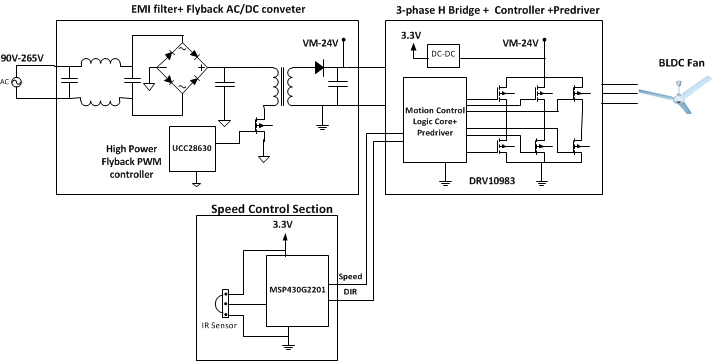SSZTCS8 april 2015 DRV10983 , MSP430G2201 , UCC28630
Rapid advancement in power electronics technologies and wider availability of highly integrated ICs to embed motor control algorithms now makes it easy to use a brushless DC (BLDC) motor instead of traditional induction or DC motors. BLDC motors do not have mechanical brushes and commutators so they provide higher torque/power-to-weight ratio, run efficiently and silently compared to brushed DC motors. Because there are no rotor copper losses in the permanent magnet rotor, they also provide higher efficiency over induction motors. Ceiling fan can gain significant energy efficiency by taking advantage of a BLDC motor. Let’s take a look at how to develop such a system using a three-phase BLDC motors.
Traditionally, single-phase induction motors dominated the ceiling fan segment because they can run directly from most commonly available power sources in homes/offices (i.e. 110V/60Hz or 230V/50 Hz). However, these induction motors are power hungry and mostly run at a typical efficiency level of around 30-40%. For example, let’s say to deliver a certain amount of air-flow, the mechanical power requirement is 20 watts. Input electrical power taken from these motors would be about 55-65 watts, depending on how optimally the motor is designed. In addition, the speed control mechanism by controlling the voltage adds additional losses to system and fluctuations of the input voltage, making it very challenging to have constant speed control.
Figure 1 shows one possible approach to enhance the energy efficiency of a ceiling fan system using a 24-V, three-phase BLDC motor. Over-all system efficiency is governed by three-major system blocks, first is BLDC motor itself including blades, second is three-phase DC/AC stage and third is AC-DC stage. With proper design of efficiencies of each system block, input power consumption can be brought down to the 30-35 watt level. In the approach below, a 24-V BLDC motor brings the advantage of achieving constant speed of operation throughout universal main AC range of 90-265 volts and fluctuations in voltage does not affect the motor speed. The other major factor to consider is right motor control strategy. For best utilization of motor efficiency, and to run the motor silently, it is important to run the BLDC motor using a sinusoidal PWM instead of a 120-dgree trapezoidal control. For speed control, a cost-effective infrared-based remote control strategy can be employed.
 Figure 1 3-phase BLDC ceiling fan
system block diagram
Figure 1 3-phase BLDC ceiling fan
system block diagramNext Step:
To enable quick development of this system, TI has developed reference design- TIDA-00386 “BLDC ceiling fan controller with sensor-less sinusoidal current control”. Figure 2 shows how this reference design provides a complete solution for a brushless DC ceiling fan controller. It features the DRV10983 24-V, three-phase motor driver to drive motors with sinusoidal current and sensor-less control. The UCC28630 is primary-side PWM controller IC -provides PWM to AC/DC fly-back stage to convert 90-265 VAC into a tightly regulated 24 VDC. The MSP430G2201 value-line processor decodes infrared signals for speed control.
 Figure 2 Functional block diagram of
BLDC ceiling fan controller reference design
Figure 2 Functional block diagram of
BLDC ceiling fan controller reference designLearn more about the TIDA-00386 BLDC ceiling fan controller with sensor-less sinusoidal current control
Thanks for reading, and your comments are welcome below.